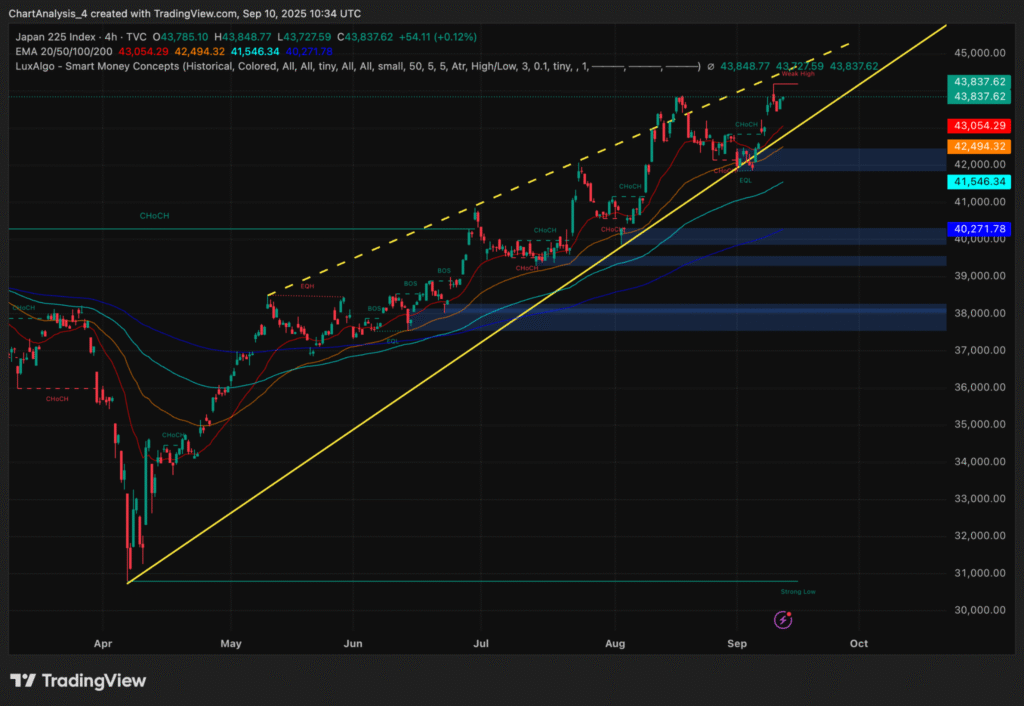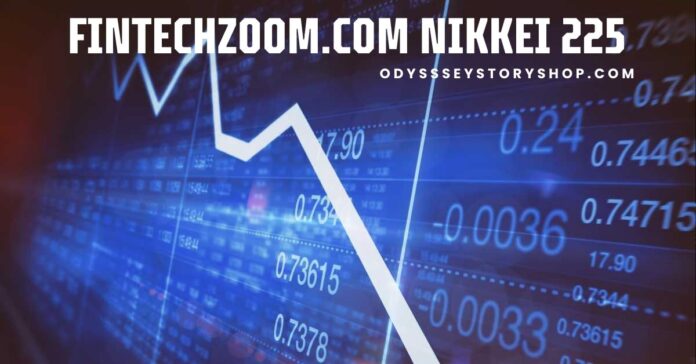The phrase fintechzoom.com nikkei 225 has recently become a trending search among global investors who want a deeper understanding of Japan’s most important stock market index. The Nikkei 225 is often compared to the Dow Jones Industrial Average in the United States because it tracks the performance of 225 leading companies in Japan across different industries.
Fintechzoom.com provides insights into this index, breaking down its daily performance, long-term movements, and its impact on both Japanese and global markets. In this article, we will explore the history, composition, importance, and future outlook of the Nikkei 225, while highlighting why fintechzoom.com has become a trusted platform for following this benchmark.
What is the Nikkei 225?
The Nikkei 225 is Japan’s oldest stock index, launched in 1950. It covers 225 blue-chip companies listed on the Tokyo Stock Exchange (TSE). Unlike capitalization-weighted indices such as the S&P 500, the Nikkei 225 is a price-weighted index, meaning stocks with higher share prices have more influence on the index value, regardless of the company’s market capitalization.
This unique methodology sometimes creates surprising results. For example, a stock priced at ¥50,000 can sway the index more than a stock worth ¥500, even if the latter belongs to a much larger corporation.

Historical Background of the Nikkei 225
Post-war beginnings
The Nikkei 225 was established in September 1950, just five years after World War II, as Japan sought to rebuild its economy. It quickly became a barometer of the nation’s recovery and industrial progress.
Japan’s economic miracle
During the 1960s–1980s, Japan experienced rapid industrial growth, with companies like Toyota, Sony, and Panasonic becoming global leaders. This period saw the Nikkei 225 surge, reaching its all-time high of nearly 39,000 points in December 1989.
The lost decade
The 1990s were marked by an economic slowdown after Japan’s asset bubble burst. The Nikkei 225 plummeted and took decades to recover. Analysts often refer to this as Japan’s “lost decade,” though its effects lasted much longer.
Recent performance
In recent years, the index has shown resilience, supported by innovation in sectors like robotics, semiconductors, and finance. Government reforms and global investor interest in Asian markets have also helped stabilize its long-term outlook.
Also Read: Travel Smart OdysseyStoryShop: A Simple, Complete Guide For Modern Travelers
Why fintechzoom.com Covers the Nikkei 225
Fintechzoom.com specializes in simplifying complex financial news for a broad audience. By focusing on the fintechzoom.com nikkei 225 coverage, the platform provides:
- Daily updates on index performance.
- Analysis of key sectors driving growth.
- Insights into global economic links between Japan and other markets.
- Investor guides on how to trade or invest in the Nikkei 225.
This user-friendly approach makes it easier for U.S. investors and beginners to understand one of the world’s most important indices.
Key Companies in the Nikkei 225
The Nikkei 225 includes companies across multiple sectors, such as:
- Technology: Sony, Tokyo Electron, SoftBank Group.
- Automobiles: Toyota, Honda, Nissan.
- Finance: Nomura Holdings, Mitsubishi UFJ Financial.
- Consumer goods: Fast Retailing (parent company of Uniqlo), Shiseido.
- Industrials: Hitachi, Kawasaki Heavy Industries.
These companies represent the backbone of Japan’s economy and highlight the diversity within the index.
How the Nikkei 225 is Calculated
The index uses a price-weighted method. This means:
- A company’s stock price is the deciding factor for its influence.
- Higher-priced stocks have more weight.
- Adjustments are made when companies undergo stock splits, mergers, or other corporate actions.
While some critics argue this method does not reflect true market value, supporters believe it highlights price momentum and market sentiment more directly.
Global Significance of the Nikkei 225
Why should American or global investors care about the Nikkei 225?
- Economic barometer: It reflects the health of the Japanese economy, which is the third largest in the world.
- Technology leadership: Japan remains a leader in robotics, semiconductors, and consumer electronics.
- Trade relationships: Japan has deep trade ties with the U.S., Europe, and Asia, so shifts in its economy affect global supply chains.
- Investor diversification: Exposure to the Nikkei 225 offers a hedge for investors who want to diversify beyond Western markets.
fintechzoom.com nikkei 225 and U.S. Investors
For U.S. investors, fintechzoom.com provides practical guides on:
- How to trade ETFs linked to the Nikkei 225.
- Using futures and options for risk management.
- Understanding currency effects, since the Japanese yen plays a key role in returns.
Many U.S. brokerage platforms offer funds that track the Nikkei 225, making it accessible even for small retail investors.
Challenges Facing the Nikkei 225
- Aging population: Japan faces demographic issues, with one of the oldest populations in the world.
- Deflationary pressures: Economic stagnation and low inflation rates have slowed growth.
- Global competition: South Korea, China, and India are rising as economic powers.
- Price-weighted limitations: The methodology can sometimes distort the index’s true market picture.
Opportunities Ahead
Despite challenges, the Nikkei 225 also has exciting opportunities:
- Innovation in green tech and robotics.
- Digital transformation across industries.
- Corporate governance reforms encouraging transparency.
- Growing foreign investment in Japanese stocks.
Fintechzoom.com often highlights these opportunities in its analysis, showing how the Nikkei 225 remains relevant to global markets.
Practical Investment Strategies
Investors can gain exposure to the Nikkei 225 through:
- ETFs (Exchange-Traded Funds): Popular ones include iShares Nikkei 225 ETF.
- Index futures: For experienced traders seeking leverage.
- ADR (American Depositary Receipts): U.S. investors can buy shares of Japanese companies like Toyota and Sony directly on American exchanges.
- Global funds: Many international funds allocate capital to Nikkei 225 companies.
fintechzoom.com nikkei 225 Market Analysis
Fintechzoom.com combines news updates with accessible analysis. For example, when global events like U.S. Federal Reserve interest rate changes or oil price fluctuations occur, fintechzoom.com explains how these developments influence the Nikkei 225.
This approach helps everyday investors make informed decisions without getting lost in technical jargon.
Long-Term Outlook for the Nikkei 225
Experts suggest that while Japan faces structural challenges, the long-term outlook for the Nikkei 225 remains positive due to:
- Continued demand for advanced manufacturing.
- Growth in clean energy industries.
- Increased participation by global investors.
- Political stability compared to some neighboring economies.
FAQs about fintechzoom.com nikkei 225
What is fintechzoom.com nikkei 225?
It refers to coverage by fintechzoom.com on Japan’s Nikkei 225 stock index, offering news, updates, and investor insights.
How is the Nikkei 225 different from the S&P 500?
The Nikkei is price-weighted, while the S&P 500 is market capitalization-weighted. This means they track companies differently.
Can U.S. investors buy into the Nikkei 225 directly?
Not directly, but they can access it through ETFs, futures, ADRs, and global funds.
Why is the Nikkei 225 important for global markets?
Because Japan is a major economy and its companies play a key role in global supply chains, especially in technology and automotive sectors.
Does fintechzoom.com give real-time updates?
Yes, fintechzoom.com regularly updates market data and provides easy-to-understand analysis.
What risks should investors consider?
Currency fluctuations, Japan’s demographic challenges, and the unique price-weighted methodology of the index.
How often is the Nikkei 225 reviewed?
The index is reviewed annually to reflect changes in the Japanese economy and ensure accuracy.
Conclusion
The fintechzoom.com nikkei 225 is more than just a financial headline—it represents the heartbeat of Japan’s economy and an important window into global markets. For U.S. investors and curious learners, fintechzoom.com makes understanding this index simpler, clearer, and more actionable.
By combining history, analysis, and future insights, this article shows that following the Nikkei 225 is not just about numbers; it’s about understanding a nation’s role in the ever-changing global economy.

